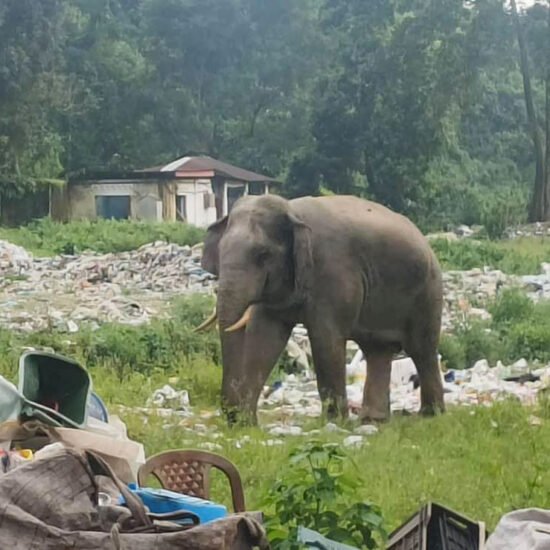August 29, 2024
SAMTSE – Farmers of Samtse are no strangers to elephants and the scale of destruction a herd of jumbos can unleash on agriculture fields, homes, and human lives.
For decades, gewogs like Tashichhoeling in Samtse have been at the receiving end of this human-elephant conflict.
Since 2019, Tashichhoeling alone has reported 309 human-elephant conflict incidents, peaking in 2020 with 155 cases. Forestry officials, however, estimate the actual number is four times higher.
During this period, the elephants destroyed around 2,290 betel nut trees, damaged 24 properties, and took two human lives.

The chief forestry officer of Samtse Forest Division, Kuenley Gyeltshen, said that the division was instituting a conflict-to-coexistence programme to enable people and elephants to share the space and co-exist. PHOTO: KUENSEL
Despite decades of human-elephant conflict, no effective solution is available to fully protect farms, people, and thier livelihoods. If Samtse Forest Division’s co-existence measure succeeds, this could help mitigate the problem to some extent.
The chief forestry officer of Samtse Forest Division, Kuenley Gyeltshen, said that the division was instituting a conflict-to-coexistence programme to enable people and elephants to share the space and co-exist.
“We aim to transform conflict into coexistence by promoting sustainable and reliable interventions and studying movement patterns,” Kuenley Gyeltshen said. “There is no permanent solution to completely mitigate human-wildlife conflict. We have to learn to coexist.”
Solar fencing, waterholes in forests away from human settlements, grassland enrichment, fruit plantations, and salt licks are strategies that will be implemented to manage wildlife and reduce human-wildlife conflicts.
Mitigation efforts, however, require community participation, as well as material and financial resources.
The forest division is also trying to secure funds to use a movement tracking system.
“We also need to provide training to the Quick Reaction Team (QRT), and if possible, offer incentives to encourage their active participation,” Kuenley Gyeltshen said.
Initiatives and challenges
Several preventative measures and management strategies implemented in the past have proven ineffective in mitigating human-elephant conflict.
The measures include large boulder walls, solar and bio-fences, creation of waterholes, watchtowers to monitor elephant movement and alert the community, sound alert systems, camera traps, and audio-visual deterrents.
Alternative crop cultivation, planting buffer plant species, and introducing agave, bamboo, and banana plants in the Lower Penjorling area were ineffective.
The QRT, comprising 50 community volunteers, was established and provided with safety gears such as flashlights, rain boots, and raincoats. However, residents claim that the team is mostly inactive during incidents.
Forestry officials said that only a few volunteered for the QRT and the lack of community support discourages them.
Some residents suggested that constructing physical walls could help mitigate the elephant encroachment but budget constraints remain a challenge. However, forestry officials discourage this approach, as such measures affect movement of other wildlife.
Forestry staff and QRT volunteers face challenges due to a lack of pool vehicles for rapid response. And their dispersed locations impact coordination and response times. “Providing designated quarters would enhance the effectiveness of night patrols and incident management,” a forestry official said.
The lack of wireless communication, a sense of ownership, technical capacity, equipment, facilities, and compensation schemes also strain ongoing efforts to mitigate human-wildlife conflicts.
The Tashichhoeling range office is currently short of seven staff members required for 24-hour shifts. “The current seven staff members who handle nighttime wildlife conflict response come to the office the next morning to provide services,” Kuenley Gyeltshen said.
An uneasy coexistence
With a significant reduction in elephant habitats on both sides of the Bhutan-India border due to expanding human settlements, the number of human-elephant conflicts has increased over the years.
The habitat adjacent to Gorumara National Park and Chapramari Wildlife Sanctuary in West Bengal, India, was the last remaining habitat for elephants in Samtse.
Elephant habitats are mostly surrounded by farmlands. Lower Penjorling in Samtse, located adjacent to these habitats, is particularly vulnerable to crop damage by elephants.
Infrastructure development in Lower Penjorling has also intensified elephant encroachment in Upper Penjorling and Singyegang over the years.
Fifty-year-old Tashi Wangmo from Lower Penjorling said that her family members take turns to keep watch for elephants during the night. “We stay active in the community WeChat group to alert and update each other about any elephant sightings.”
The situation is exacerbated when farmers plant crops that elephants prefer, such as bamboo, bananas, maize, vegetables, and areca nut plants. These cash crops are the primary source of income for most farmers.
“A herd of eight elephants damaged about 80 areca nut plants in my field. We cannot go out alone even during the day,” said 60-year-old Kuenzangmo, adding that the elephants also damaged her neighbor’s single-storey house.
The increased human-elephant conflict has also resulted in vast swathes of fertile land between Singyegang and Penjorling being left barren for decades.
Forty-four-year-old farmer Autwa Uraon from Singyegang abandoned his 75 decimals of wetland about 20 years ago and instead chose to work as a sharecropper. “It was productive land before the elephant started coming in the 1990s,” he said.
Parents are also concerned about the safety of their school-going children
Farmers believe that without the implementation of sustainable solutions, there will be no respite from elephant predation.


